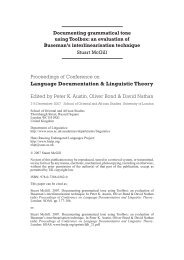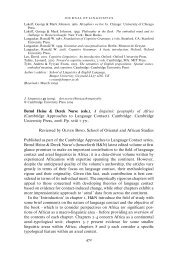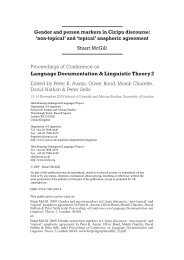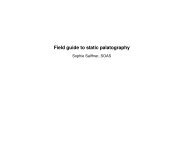Palatography – Phonetics tutorial week 10
Palatography – Phonetics tutorial week 10
Palatography – Phonetics tutorial week 10
Create successful ePaper yourself
Turn your PDF publications into a flip-book with our unique Google optimized e-Paper software.
<strong>Palatography</strong> workshop outline<br />
<strong>Palatography</strong> workshop<br />
Sophie Salffner, SOAS<br />
These are tutor’s notes for a palatography workshop. The aim of the workshop is to<br />
introduce students and field linguists to doing palatography in the field so that they are in a<br />
position to identify sounds that can be investigated with palatography, put together a list of<br />
words that can be used to record these sounds and take linguograms and palatograms of the<br />
sounds in questions and evaluate and improve the quality of the linguograms and<br />
palatograms they have taken. In addition, we discuss ethical issues in conducting<br />
palatography work with consultants.<br />
What is not included in the workshop is the description, interpretation and analysis of<br />
linguograms and palatograms. This can become part of a follow-up workshop or can be<br />
done together with a trained phonetician upon return to the university.<br />
The workshop is designed for participants who know the basics of articulatory phonetics.<br />
The participants are not expected to have detailed knowledge of the articulatory phonetics<br />
or remember everything they learned about the subject at some stage of their training.<br />
Therefore, a brief review of articulatory phonetics is included as part of the workshop. 1<br />
1 Brief background and introduction<br />
- There are three broad areas within phonetics: articulatory, acoustic, auditory<br />
phonetics.<br />
- The study of articulation involves investigating the position and movement of<br />
the speech organs above the larynx.<br />
- There are static and dynamic aspects to articulation: palatography catches the<br />
target position for a speech sound, that is static side of articulation.<br />
2 What is palatography?<br />
- a group of techniques to record contact between the tongue and the roof the<br />
mouth to get articulatory records for the production of speech sounds<br />
- In brief, it involves putting a marker paint on the tongue, pronouncing a word<br />
and seeing where ink rubbed off onto the roof of the mouth. This gives the place<br />
of articulation. Also, the roof of the mouth can be painted and it can be<br />
investigated where the ink rubbed off onto the tongue. These two types of<br />
records are called palatograms and linguograms respectively.<br />
1 I am grateful to Justin Watkins and Bonny Sands for comments and feedback on this workshop.<br />
Sophie Salffner, SOAS, May 20<strong>10</strong><br />
1
<strong>Palatography</strong> workshop outline<br />
- There are many other techniques and more sophisticated techniques, we will get<br />
back to them later.<br />
As the teacher, here you can show a slideshow of the tools and steps in doing<br />
palatography.<br />
3 Review of articulatory phonetics<br />
In phonetics, we make a broad distinction into vowels and consonants. Broadly<br />
speaking,<br />
- vowels involve no obstruction of airflow (although for high vowels there is<br />
contact between the side of the tongue and the teeth/the top of the mouth)<br />
- consonants have an obstruction of airflow somehow, somewhere<br />
- since palatography requires contact, i.e. some kind of obstruction, for the paint<br />
to rub off, palatography is most suitable for looking at consonants <strong>–</strong> so let’s look<br />
at consonants in more detail<br />
The features that characterise consonants are<br />
1. airstream mechanism (pulmonic, glottalic, velaric)<br />
2. direction of airstream (egressive, ingressive)<br />
3. state of the glottis (voiced, voiceless, creaky, breathy, whisper)<br />
4. tongue (apical, laminal, retroflex, dorsal, radical)<br />
5. place of articulation (bilabial, labiodental, labiovelar, (labiolingual), dental,<br />
alveolar, retroflex, palato-alveolar, palatal, velar, uvular, phraryngeal, glottal)<br />
6. centrality (central, lateral)<br />
7. nasality (oral, nasal)<br />
8. manner of articulation (stop, fricative, affricate, approximant, trill, flap, tap)<br />
9. secondary articulations (labialisation, palatalisation, velarisation, nasalisation)<br />
Since palatography requires contact between the painted articulator and the articulator<br />
where the paint will rub off to, not all types of consonants can be investigated with<br />
Sophie Salffner, SOAS, May 20<strong>10</strong><br />
2
<strong>Palatography</strong> workshop outline<br />
palatography <strong>–</strong> only those where there is contact between the tongue and one of the<br />
articulators opposite the tongue. Of the features above, this disqualifies<br />
- pulmonic and glottalic airstream mechanism, though the place of articulation in<br />
consonants produced with these airstream mechanisms can still be investigated<br />
- the direction of airstream<br />
- voicing contrasts, though there may still be differences in degree of occlusion in<br />
voiceless vs. voiced fricatives for example which can be seen in palatograms<br />
- places of articulation of articulation that are too far front or too far back<br />
(bilabial, labiodental, pharyngeal and glottal, and for some speakers velar and<br />
uvular because there is only so far back that you can paint the tongue before<br />
people start gagging)<br />
- nasality<br />
- the distinction between some manners of articulation because they all involve<br />
total closure (plosives, nasals, affricates, trills)<br />
After all the disqualified bits have been taken out, we can determine the place and to<br />
some degree the manner of articulation for these pulmonic sounds of the IPA shown in<br />
the red boxes in Figure 1.<br />
Sophie Salffner, SOAS, May 20<strong>10</strong><br />
3
<strong>Palatography</strong> workshop outline<br />
Figure 1: Sounds and features that can be investigated with palatography<br />
Sophie Salffner, SOAS, May 20<strong>10</strong><br />
4
<strong>Palatography</strong> workshop outline<br />
4 Deciding what words to use<br />
Not all words are suitable for palatography. For example, if you did a palatogram of the<br />
word ‘sprinkle’ <strong>–</strong> what would you get? Of the word ‘onion’? Of ‘Dshengis Khan’? A<br />
mess! So you can’t just have any word with any combination of sounds.<br />
Requirements for test words<br />
- includes the sound you want to investigate<br />
- other sounds should be vowels or bilabial or glottal consonants<br />
- vowels should be the same for words that are compared <strong>–</strong> minimal pairs are<br />
good<br />
- preferably not high vowels because you get contact at the sides<br />
- common words that the speakers are familiar with<br />
Task for the participants<br />
Choose a language to look at (preferably one you speak yourself), get the consonant<br />
inventory and identify all the sounds you can investigate with palatography. Compile<br />
your own word lists with the sounds to test for. Include a few bad choices to see why<br />
they are bad and some examples where you are not sure where they are good or bad.<br />
If you want, include some examples to try out how far back in the mouth you are<br />
comfortable to go <strong>–</strong> palatals, velars, maybe even uvulars?<br />
5 DIY<br />
5.1 Equipment<br />
- intraoral mirrors (I buy cheap small metal-encased hand mirrors for travelling,<br />
e.g. in the UK from Muji, or expensive dentist supply intraoral mirrors)<br />
- brushes (children’s paint brushes will do, softer ones feel nicer on the skin)<br />
- charcoal powder, chocolate powder or other material for making the paint<br />
(chemists and health stores have activated charcoal intended as a digestive aid,<br />
absolutely not toxic, even good for you, in the UK Holland & Barrett sells it)<br />
Sophie Salffner, SOAS, May 20<strong>10</strong><br />
5
<strong>Palatography</strong> workshop outline<br />
- vegetable oil<br />
- antiseptic spray (the type that can be used on skin but needs to be rinsed off<br />
carefully as it should not be ingested)<br />
- photo camera or video camera<br />
- tripod<br />
- a source of light (flash light on the camera or extra light)<br />
- pineapple, fruit juice or drink mix to wash the paint out off the mouth<br />
- cloths, tissues, detergent, hot water<br />
5.2 Preparations<br />
- get your equipment together and set up<br />
o word list<br />
o mirrors, paste, brushes, tissues, cloths and towels, water, pineapple<br />
o make sure you have one set of pot, brush, mirror, cloths and pineapple<br />
per speaker (hygiene!)<br />
o camera on the tripod<br />
- prepare the paint<br />
o in separate pots for each speaker<br />
o charcoal powder and oil roughly 1:1<br />
o it shouldn’t drip, it shouldn’t have lumps anymore either, it shouldn’t be<br />
too thick, the idea is to have a smooth paint that is easy to brush on<br />
quickly and won’t drip off the tongue <strong>–</strong> an “eye” for the right<br />
consistency develops with time<br />
- practice putting in the mirror to take records of the palate<br />
o head tilted back, mouth wide open<br />
o mirror rests at the edge behind the upper teeth, 45° angle to the plane of<br />
the upper teeth so that all teeth from the front teeth to the last molars can<br />
be seen<br />
o as little breathing through the mouth as possible to avoid fogging the<br />
mirror<br />
Sophie Salffner, SOAS, May 20<strong>10</strong><br />
6
<strong>Palatography</strong> workshop outline<br />
o fingers should not be in the way of the palatograms<br />
o there should be enough light to actually see the inside of the mouth<br />
- practice taking records of the top, sides and underneath of the tongue<br />
o let tongue rest on the lower lip<br />
o move the tongue right, left and up to show the sides and underneath of<br />
the tongue<br />
- shoot test films and test photos without the paint<br />
- if you are recording with a video camera, it is best to just start recording and let<br />
the camera run, that way you don’t miss any words and don’t have to wait or<br />
worry<br />
- if you take photos with a still camera, be ready to take photos the moment the<br />
speaker finished pronouncing the word and get a number of shots from all angles<br />
of the tongue<br />
- have a look at your test photos and evaluate their quality<br />
o Are they light enough or too dark?<br />
o Is the whole mouth visible or are parts missing, like the front or the back<br />
teeth?<br />
o Is the angle okay?<br />
- if you can, let one person do the recording and note keeping and one person do<br />
the instructing, painting and cleaning<br />
- it may help to have the words written on a sheet of paper and to take a photo of<br />
the speaker holding the sheet with the word before taking a photo of the<br />
linguogram/palatogram so as not to lose track of which picture is which word,<br />
alternatively you can have a numbered word list and take pictures of the speaker<br />
showing 1, 2, 3 etc. with their fingers to see which word is the next to be<br />
pronounced<br />
Preparing and testing equipment even before going out to a field session is very<br />
important. It should never be assumed that all the equipment will work in the field.<br />
Sophie Salffner, SOAS, May 20<strong>10</strong><br />
7
<strong>Palatography</strong> workshop outline<br />
5.3 Linguograms<br />
It’s best to start with linguograms, i.e. with painting the palate to look at the part of the<br />
tongue that is involved in the pronunciation. That’s because it may be that after a few<br />
palatograms the tongue doesn’t get very clean anymore and there simply isn’t enough<br />
contrast for you to see anything.<br />
The procedure is as follows:<br />
- let the speaker rest the head back<br />
- paint the roof of the mouth quickly, as far back as necessary<br />
- be careful, some speakers have very ticklish palates<br />
- let the speaker pronounce the test word once<br />
- the speaker must not swallow or do anything else with his or her tongue<br />
- let the speaker rest the tongue on the lower lip and take photos, let the speaker<br />
move the tongue to the right, to the left and up to show the sides and underneath<br />
and take photos<br />
- write down the word you recorded, the speaker and the file name<br />
- let the speaker clean up by chewing a chunk of pineapple and swooshing it<br />
around in his or her mouth<br />
Task for the participants: Look at the differences and similarities between<br />
- [ t ] and [ ʈ ] <strong>–</strong> the alveolar and the retroflex voiceless stop<br />
- [ ʈ ] as retroflex plosive and [ ɽ ] as retroflex tap/flap<br />
- different people’s [ s ] sounds, for example English vs. Greek speakers, or<br />
many different speakers of the same language<br />
5.4 Palatograms<br />
For palatograms, it is the tongue that is painted and the roof of mouth that is recorded.<br />
- pad the tongue dry with kitchen towel or a cloth<br />
- apply the paste quickly, from the front to the back of the tongue including the<br />
sides, also underneath the tip of the tongue for some sounds such as retroflexes<br />
Sophie Salffner, SOAS, May 20<strong>10</strong><br />
8
<strong>Palatography</strong> workshop outline<br />
- let the speaker pronounce the test word once<br />
- the speaker must not swallow or do anything else with their tongue<br />
- let the speaker insert the mirror at the edge behind the upper teeth at a 45° angle<br />
- the speaker must avoid breathing through the mouth so as not to fog the mirror<br />
- take photos of the reflection in the mirror, using additional lighting if necessary<br />
- write down the word you recorded, the speaker and the file name<br />
- let the speaker clean up by eating a chunk of pineapple<br />
Suggested tasks for the participants<br />
Look at the differences and similarities between<br />
- [ s ] and [ ɬ ] <strong>–</strong> central and lateral airflow<br />
- [ l ] and [ ɬ ] <strong>–</strong> approximant and fricative<br />
- [ n ] and [ t ] <strong>–</strong> no difference<br />
- [ t ] and [ s ] <strong>–</strong> difference<br />
- [ t ] and [ ts ] <strong>–</strong> no difference<br />
- Arabic and Spanish [ t̪ ] and English [ t ] <strong>–</strong> dental and alveolar<br />
- [ θ ] and [ s ] <strong>–</strong> dental and alveolar<br />
- different people’s [ s ] sounds <strong>–</strong> all are central phonetically speaking but<br />
some are median, i.e. also central physiologically speaking in that the gap is<br />
by the front teeth whereas others are a bit “off target” where the gap is not in<br />
the middle physiologically speaking but maybe a bit to the side<br />
- Korean contrast in fortis <strong>–</strong> lenis <strong>–</strong> aspirated [ t͈ t tʰ ]<br />
5.5 Potential problems<br />
- Speaking with your mouth painted is very strange and the first few palatograms<br />
are likely to go wrong. The consultant can practise saying the word in isolation<br />
until he or she feels comfortable and then have the tongue painted to say the<br />
Sophie Salffner, SOAS, May 20<strong>10</strong><br />
9
<strong>Palatography</strong> workshop outline<br />
word. Another way is to think of what the word means and then say is rather<br />
that being overly worried about the pronunciation.<br />
- Getting the angle of the mirror right and opening the mouth far enough to get a<br />
full view of the palate until the last molars may take some practice. In Figure 2,<br />
the mouth is not open far enough and the angle is so that we cannot tell if the<br />
sound produced here is [ l ] or [ t ] because we cannot see if there is contact at<br />
the last molars. In Figure 3, the angle is so that we cannot see the front teeth.<br />
- Also, the consultants may be covering the mirror with their hands. For example<br />
in Figure 3, the fingers cover part of the imprint on the palate.<br />
Figure 2<br />
Figure 3<br />
It may help to structure the workshop so as to take some linguograms and palatograms,<br />
then come together to look at the photographs, evaluate their quality, discuss problems<br />
that occurred and give advice on how to improve the photographs. The participants can<br />
then return to making more (and hopefully better) linguograms and palatograms.<br />
5.6 Metadata<br />
It is important to note down the speaker and the test word for each photograph that is<br />
taken because this is not easy to work out afterwards if you have forgotten. Else you<br />
can take pictures of the word itself or the number as mentioned above.<br />
Sophie Salffner, SOAS, May 20<strong>10</strong><br />
<strong>10</strong>
<strong>Palatography</strong> workshop outline<br />
In addition, it is useful to have a picture of the palate without any imprints for<br />
reference. Ideally, you should also have a cast of the palate but we will not cover this<br />
here. For notes on how to take palate casts see the reading at the end of these notes.<br />
5.7 Hygiene and cleaning up<br />
- for each consultant have a clean brush, clean pot, clean mirror, clean cloths and<br />
tissues and new paste, all clearly separate from each other<br />
- wash, disinfect and let everything dry completely after use<br />
o brushes: hot soapy water until no more black charcoal comes out, soak in<br />
disinfectant solution for at least 15min, let them dry completely, then<br />
rinse off disinfectant solution and let dry completely again<br />
o mirrors: clean with hot soapy water and possibly a toothbrush to get the<br />
paint out of the corners if there are any, treat with disinfectant spray and<br />
let dry, rinse off disinfectant spray and let dry again<br />
o consultants: pineapples<br />
- depending on the consultants and the special requirements of potential human<br />
subjects committees at the institution you are working with, re-using sterilised<br />
equipment may not be enough, you may have to use new brushes and mirrors for<br />
each participant<br />
6 Data interpretation<br />
Data interpretation is not covered in this workshop, though it is useful to collect records<br />
taken throughout the workshop and look at their quality <strong>–</strong> can the whole mouth be seen?<br />
Is there enough light? Is the angle correct? Do the fingers obstruct the view?<br />
For examples of palatograms see Straka 1965.<br />
7 Ethical issues and involving your consultants<br />
7.1 Ethical issues<br />
While palatography is not as invasive as other techniques in experimental phonetics, it<br />
is more invasive than many fieldwork methodologies in other areas of linguistics and<br />
therefore more sensitive. Still, the guidelines for working with palatography are fairly<br />
common sense and should be familiar to trained and culturally sensitive fieldworkers.<br />
Some helpful guidelines are<br />
Sophie Salffner, SOAS, May 20<strong>10</strong><br />
11
<strong>Palatography</strong> workshop outline<br />
- wait with doing palatography until you have established a good working<br />
relationship with the consultants and until they have seen you do work that<br />
might seem a bit strange from their perspective<br />
- observe and learn from<br />
o how people prepare food<br />
o how people touch each other (in particular around the head and in the<br />
face)<br />
o how people deal with and react to body liquids such as saliva<br />
o how people use their left and right hand (again in particular around the<br />
head and the mouth, especially if you are left-handed)<br />
- don’t put anyone under pressure<br />
7.2 Involving consultants<br />
Explain to your consultants what you are doing and motivate why you are doing this.<br />
- demonstrate similarities with handprints <strong>–</strong> people’s handprints are all different<br />
- explain what you’ll be doing, what materials you are using, show on yourself, let<br />
them try, let them pull out at any point that they wish<br />
- appeal to people’s sense of fun <strong>–</strong> you or your participants may want to paint<br />
your eyebrows, you could do face painting, people might end up trying to tease<br />
each other by getting the paint on each other’s faces, …<br />
- show the results and explain how people differ in their pronunciation<br />
- let people paint their own tongues and insert the mirrors themselves<br />
8 Articulatory phonetics beyond palatography<br />
Other techniques for investigating articulation are<br />
- imaging techniques<br />
o film and photography<br />
o X-ray film and photography<br />
o ultrasound<br />
o magnetic resonance imaging (MRI)<br />
Sophie Salffner, SOAS, May 20<strong>10</strong><br />
12
<strong>Palatography</strong> workshop outline<br />
- point-tracking techniques<br />
o optical systems: LEDs attached to face<br />
o electromagnetic systems: sensor coils attached to tongue, velum, …<br />
o X-ray microbeam: metal pellets attached to tongue, … and traced<br />
- electromyography (EMG)<br />
o recording the activity of muscles by detecting the electrical activity<br />
associated with muscle contraction<br />
- electropalatography<br />
9 Further reading<br />
Anderson, Victoria. 2008. Static <strong>Palatography</strong> for Language Fieldwork. Language<br />
documentation and conservation 2, 1, 1-27. URL:<br />
http://www2.hawaii.edu/~vanderso/LDC.pdf<br />
Gibbon, Fiona and Katerina Nicolaidis. 1999. <strong>Palatography</strong>. In Coarticulation: Theory,<br />
Data and Techniques. William J. Hardcastle and Nigel Hewlitt (eds). Cambridge:<br />
Cambridge University Press. 229-245.<br />
Ladefoged, Peter. 2003. Phonetic data analysis. An introduction to fieldwork and<br />
instrumental techniques. Oxford: Blackwell Publishing.<br />
Sands, Bonny, Johanna Brugman, Mats Exter, Levi Namaseb, Amanda Miller. 2007.<br />
Articulatory characteristics of anterior click closures in N|uu. Proceedings of the<br />
International Congress of Phonetic Sciences XVI, Saarbrücken, Germany, August 2007.<br />
pp. 401-404. Available online: http://www.icphs2007.de/conference/Papers/1540/<br />
Straka, George. 1965. Album phonétique. Laval: Les Presses de l’Université Laval.<br />
Sophie Salffner, SOAS, May 20<strong>10</strong><br />
13












